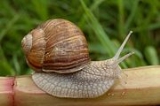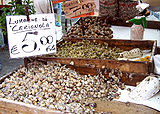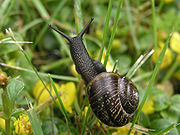
Helicidae
Encyclopedia
The Helicidae, sometimes known as the typical snails, are a taxonomic family
of small to large, air-breathing, land snail
s. In other words, they are terrestrial
pulmonate gastropod mollusks.
A number of species in this family are valued as food items, including Helix aspersa
the garden snail, and Helix pomatia
the "escargot". The biology of these two species in particular has been much studied.
s of these snails are mostly rather globular in shape. In some genera, such as Cepaea
, the shells are brightly colored and patterned.
The mouth is always provided with a jaw, which is striate, ribbed, sulcate or plicate, sometimes composed of several imbricating pieces. The radula
is composed of many transverse horizontal series of teeth, the centrals tricuspidate, about the size of the laterals, laterals bicuspid, or tricuspid with the interior cusp obsolete, marginals usually wider than high, short with two or three small cusps.
In the soft parts the most obvious distinction is the lack of a caudal mucous pit
, and their possessing a sculptured jaw. Typically, there is a distinction in the dentition, although in some species the lateral teeth take on a pseudozonitoid appearance; even in such cases the extreme marginals in Helix remain short and very obtuse.
This family of snails is defined by the anatomical presence of a diverticulum
. Some genera within this family create and use love dart
s as part of their mating behavior. These snails have one dart apparatus. The dart sac has no accessory sac, and contains two tubular glands, inserted at the base of the dart sac.
In this family, the number of haploid chromosome
s lies between 21 and 30 (according to the values in this table).

and belongs the Western Palearctic
group.
However some of the species, for example Helix aspersa
, have been introduced and become established in numerous different areas worldwide.
Many accidental introductions happen because the eggs of most Helicidae are laid in the soil, and they may thus easily travel unnoticed along with landscaping plants.

 The family Helicidae contains 2 subfamilies (according taxonomy of the Gastropoda by Bouchet & Rocroi, 2005
The family Helicidae contains 2 subfamilies (according taxonomy of the Gastropoda by Bouchet & Rocroi, 2005
) and genera within the family Helicidae include (after Fauna Europaea and Taxonomy Browser):
Subfamily Helicinae Rafinesque, 1815 - In this subfamily the glands are divided. The love dart has four blades or vanes. There are two penial papillae.
Subfamily Ariantinae Mörch
, 1864 - in this subfamily the glands are divided or undivided. The love darts contain two to four blades. There is only one penial papilla.
Family (biology)
In biological classification, family is* a taxonomic rank. Other well-known ranks are life, domain, kingdom, phylum, class, order, genus, and species, with family fitting between order and genus. As for the other well-known ranks, there is the option of an immediately lower rank, indicated by the...
of small to large, air-breathing, land snail
Land snail
A land snail is any of the many species of snail that live on land, as opposed to those that live in salt water and fresh water. Land snails are terrestrial gastropod mollusks that have shells, It is not always an easy matter to say which species are terrestrial, because some are more or less...
s. In other words, they are terrestrial
Terrestrial animal
Terrestrial animals are animals that live predominantly or entirely on land , as compared with aquatic animals, which live predominantly or entirely in the water , or amphibians, which rely on a combination of aquatic and terrestrial habitats...
pulmonate gastropod mollusks.
A number of species in this family are valued as food items, including Helix aspersa
Helix aspersa
Helix aspersa, known by the common name garden snail, is a species of land snail, a pulmonate gastropod that is one of the best-known of all terrestrial molluscs. The species has been placed in the genus Helix, in all sources between 1774 and 1988 and in most sources until recently...
the garden snail, and Helix pomatia
Helix pomatia
Helix pomatia, common names the Burgundy snail, Roman snail, edible snail or escargot, is a species of large, edible, air-breathing land snail, a terrestrial pulmonate gastropod mollusk in the family Helicidae...
the "escargot". The biology of these two species in particular has been much studied.
Shell description
The shellGastropod shell
The gastropod shell is a shell which is part of the body of a gastropod or snail, one kind of mollusc. The gastropod shell is an external skeleton or exoskeleton, which serves not only for muscle attachment, but also for protection from predators and from mechanical damage...
s of these snails are mostly rather globular in shape. In some genera, such as Cepaea
Cepaea
Cepaea is a genus of medium-sized air-breathing land snails, terrestrial pulmonate gastropods in the family Helicidae, the typical snails. The shells of species within this genus are often brightly colored and patterned with stripes....
, the shells are brightly colored and patterned.
Anatomy
The animal is capable of complete retraction within the shell. The tail is without a mucous gland or projection.The mouth is always provided with a jaw, which is striate, ribbed, sulcate or plicate, sometimes composed of several imbricating pieces. The radula
Radula
The radula is an anatomical structure that is used by molluscs for feeding, sometimes compared rather inaccurately to a tongue. It is a minutely toothed, chitinous ribbon, which is typically used for scraping or cutting food before the food enters the esophagus...
is composed of many transverse horizontal series of teeth, the centrals tricuspidate, about the size of the laterals, laterals bicuspid, or tricuspid with the interior cusp obsolete, marginals usually wider than high, short with two or three small cusps.
In the soft parts the most obvious distinction is the lack of a caudal mucous pit
Caudal mucous pit
The caudal mucous pit, or caudal mucous horn, is an anatomical structure on the tail end of the foot of various land snails and slugs, terrestrial pulmonate gastropod mollusks....
, and their possessing a sculptured jaw. Typically, there is a distinction in the dentition, although in some species the lateral teeth take on a pseudozonitoid appearance; even in such cases the extreme marginals in Helix remain short and very obtuse.
This family of snails is defined by the anatomical presence of a diverticulum
Diverticulum
A diverticulum is medical or biological term for an outpouching of a hollow structure in the body. Depending upon which layers of the structure are involved, they are described as being either true or false....
. Some genera within this family create and use love dart
Love dart
A love dart is a hard, long, sharp, calcareous or chitinous dart which some hermaphroditic land snails and slugs create. Love darts are made in sexually mature animals only, and are used as part of the sequence of events during courtship, before actual mating takes place...
s as part of their mating behavior. These snails have one dart apparatus. The dart sac has no accessory sac, and contains two tubular glands, inserted at the base of the dart sac.
In this family, the number of haploid chromosome
Chromosome
A chromosome is an organized structure of DNA and protein found in cells. It is a single piece of coiled DNA containing many genes, regulatory elements and other nucleotide sequences. Chromosomes also contain DNA-bound proteins, which serve to package the DNA and control its functions.Chromosomes...
s lies between 21 and 30 (according to the values in this table).

Distribution
The family is native to EurasiaEurasia
Eurasia is a continent or supercontinent comprising the traditional continents of Europe and Asia ; covering about 52,990,000 km2 or about 10.6% of the Earth's surface located primarily in the eastern and northern hemispheres...
and belongs the Western Palearctic
Palearctic
The Palearctic or Palaearctic is one of the eight ecozones dividing the Earth's surface.Physically, the Palearctic is the largest ecozone...
group.
However some of the species, for example Helix aspersa
Helix aspersa
Helix aspersa, known by the common name garden snail, is a species of land snail, a pulmonate gastropod that is one of the best-known of all terrestrial molluscs. The species has been placed in the genus Helix, in all sources between 1774 and 1988 and in most sources until recently...
, have been introduced and become established in numerous different areas worldwide.
Many accidental introductions happen because the eggs of most Helicidae are laid in the soil, and they may thus easily travel unnoticed along with landscaping plants.
Genera


Taxonomy of the Gastropoda (Bouchet & Rocroi, 2005)
The taxonomy of the Gastropoda as it was revised by Philippe Bouchet and Jean-Pierre Rocroi is currently the most up-to-date overall system for classifying gastropod mollusks...
) and genera within the family Helicidae include (after Fauna Europaea and Taxonomy Browser):
Subfamily Helicinae Rafinesque, 1815 - In this subfamily the glands are divided. The love dart has four blades or vanes. There are two penial papillae.
- Tribe Thebini Wenz, 1923 - The synonym Euparyphinae Perrot, 1939 has been declared an invalid name.
- ThebaThebaTheba is a taxonomic genus of air-breathing land snails, medium-sized pulmonate gastropod mollusks in the family Helicidae, the true snails.Theba is the type genus of the tribe Thebini....
Risso, 1826- Tribe Helicini Rafinesque, 1815
- AllognathusAllognathusAllognathus is a genus of air-breathing land snails, terrestrial pulmonate gastropod mollusks in the family Helicidae, the true snails.-Species:Species within the genus Allognathus include:* Allognathus graellsianus...
- AssyriellaAssyriellaAssyriella is a genus of air-breathing landsnails, terrestrial pulmonate gastropod mollusk in the family Helicidae, the typical snails.- Species :Species within the genus Assyriella include:* Assyriella guttata, the type species of the genus...
- CantareusCantareusCantareus is a genus of air-breathing land snails, a pulmonate gastropod in the family Helicidae, the typical snails.Cantareus is a synonym for the genus Helix.It contains the following species:...
Risso, 1826 - CepaeaCepaeaCepaea is a genus of medium-sized air-breathing land snails, terrestrial pulmonate gastropods in the family Helicidae, the typical snails. The shells of species within this genus are often brightly colored and patterned with stripes....
Held, 1838 - CodringtoniaCodringtoniaCodringtonia is a genus of air-breathing, land snails, terrestrial pulmonate gastropod mollusks in the family Helicidae, the typical snails.-Species:Species within the genus Codringtonia include:* Codringtonia acarnanica...
- Cornu Born, 1778
- EobaniaEobaniaEobania is a genus of large, air-breathing, land snails, terrestrial pulmonate gastropod mollusks in the family Helicidae, the true snails or typical snails.-Species:The genus Eobania includes the following species:...
P. Hesse, 1913 - HelixHelix (genus)Helix is a genus of large air-breathing land snails, terrestrial pulmonate gastropod molluscs. This genus is native to Europe and the regions around the Mediterranean Sea. Helix is the type genus of the family Helicidae....
Linnaeus, 1758 - type genusType genusIn biological classification, a type genus is a representative genus, as with regard to a biological family. The term and concept is used much more often and much more formally in zoology than it is in botany, and the definition is dependent on the nomenclatural Code that applies:* In zoological... - HemicyclaHemicyclaHemicycla is a genus of medium-sized air-breathing land snails, terrestrial pulmonate gastropods in the family Helicidae, the typical snails.-Species:Species within the genus Hemicycla include:* Hemicycla adansoni* Hemicycla berkeleyi...
- IberusIberusIberus is a genus of air-breathing land snails, terrestrial pulmonate gastropod mollusks in the family Helicidae.This genus is endemic to the Iberian Peninsula.-Species and subspecies:...
- IdiomelaIdiomelaIdiomela is a genus of medium-sized air-breathing land snails, terrestrial pulmonate gastropods in the family Helicidae, the typical snails....
T. Cockerell, 1921 - LampadiaLampadiaLampadia is a genus of air-breathing land snails, terrestrial pulmonate gastropod mollusks in the family Helicidae, the true snails.- References :*...
- LeptaxisLeptaxisLeptaxis is a genus of air-breathing land snails, terrestrial pulmonate gastropod mollusks in the family Helicidae, the typical snails.Species within this genus of snails create and use love darts as part of their mating behavior.-Species:...
- Levantina
- OtalaOtalaOtala is a genus of large air-breathing land snails, terrestrial pulmonate gastropod mollusks in the family Helicidae. Archaeological recovery in Morocco indicates the exploitation of this genus by ancient Romans.-Distribution:...
Schumacher, 1817 - Pseudotachea
- TyrrhenariaTyrrhenariaTyrrhenaria is a genus of air-breathing land snails, terrestrial pulmonate gastropod mollusks in the family Helicidae, the typical snails.-References:* - External links :*...
- Tribe Murellini Hesse, 1918
- Macularia
- MarmoranaMarmoranaMarmorana is a genus of air-breathing land snails, terrestrial pulmonate gastropod mollusks in the family Helicidae.-Anatomy:Species within this genus create and use love darts as part of their mating behavior.-Species :...
W. Hartmann, 1844 - This genus might actually belong to the subfamily Ariantinae and not to the subfamily Helicinae, as has been assumed until now. - TacheocampylaeaTacheocampylaeaTacheocampylaea is a genus of air-breathing, land snails, terrestrial pulmonate gastropod mollusks in the family Helicidae.It contains the following species:* Tacheocampylaea raspaili* Tacheocampylaea tacheoides...
- TyrrheniberusTyrrheniberusMarmorana is a genus of air-breathing land snails, terrestrial pulmonate gastropod mollusks in the family Helicidae.-Species :Species within the genus Tyrrheniberus include:* Tyrrheniberus ridens...
Subfamily Ariantinae Mörch
Otto Andreas Lowson Mörch
Otto Andreas Lowson Mörch was a biologist, specifically a malacologist. He lived in Sweden, in Denmark, and in France.- Taxa described :Bibliography and taxa described by Otto Andreas Lowson Mörch include:...
, 1864 - in this subfamily the glands are divided or undivided. The love darts contain two to four blades. There is only one penial papilla.
- AriantaAriantaArianta is a medium-sized genus of European land snails, terrestrial pulmonate gastropod mollusks in the family Helicidae.Species of snails within this genus make and use calcareous love darts.-Species:Species within the genus Arianta include:...
TurtonWilliam TurtonWilliam Turton was a British naturalist.Turton was born at Olveston, Gloucestershire and was educated at Oriel College, Oxford. He commenced in practice at Swansea, but devoted his leisure time to natural history, especially conchology...
, 1831 - CausaCausaCausa is a genus of air-breathing land snails, terrestrial pulmonate gastropod mollusks in the family Helicidae.-References:* ZipcodeZoo info at:...
- ChilostomaChilostomaChilostoma is a species of medium-sized, air-breathing land snail, a terrestrial pulmonate gastropod mollusk in the family Helicidae, the true snails.- Subgenera and species :Subgenera and species within the genus Chilostoma include::...
Fitzinger, 1833 - CylindrusCylindrusCylindrus is a genus of air-breathing land snails, terrestrial pulmonate gastropod mollusks in the family Helicidae, the typical snails....
Fitzinger, 1833 - DrobaciaDrobaciaDrobacia is a genus of medium-sized air-breathing land snails, terrestrial pulmonate gastropod mollusks in the family Helicidae, the typical snails.This genus was formerly a subgenus of the genus Chilostoma.-Species:...
- Faustina
- HelicigonaHelicigonaHelicigona is a genus of medium-sized, air-breathing land snails, terrestrial pulmonate gastropod mollusks in the family Helicidae, the typical snails.-Anatomy:These snails create and use love darts during mating.-Species:...
A. Férussac, 1821 - Isognomostoma Fitzinger, 1833
- Vidovicia

